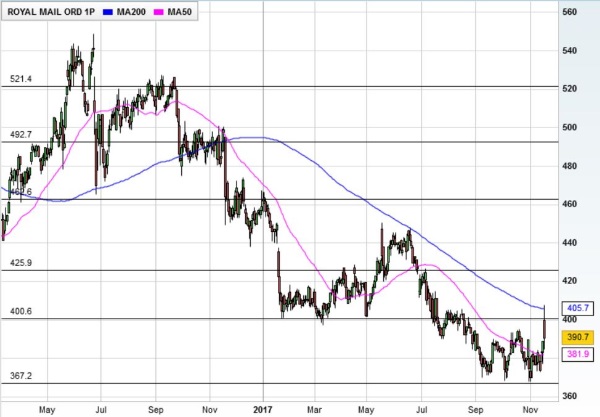Why there's huge relief at Royal Mail
16th November 2017 11:20
Concerns around oil prices and uncertainty dogging Donald Trump's tax plans kept the pressure on stocks overnight. It's risk off in London, too, where the FTSE 100 continues to loiter around six-week lows.
There's so much chatter around when this stock market bull run will end, that every sell-off is quickly heralded as the start of a correction. But remember, this is the fourth time since early June that the FTSE 100 has dropped in excess of 200 points, which is more a sign that this market is stale and requires a fresh catalyst, rather than signalling a mad rush for the exit.
Save for some headline-grabbing profit warnings, company results have been respectable and there are still few asset classes offering better returns than equities. It's also worth remembering that the FTSE 100 is still up over 8% in the past 12 months. For chart watchers, the next big level of support is 7,300.
shares have been chronic underperformers since peaking at over 600p shortly after floating in 2013, but half-year results were actually quite good.
Revenue up 2%, underlying operating profit before so-called transformation costs up 7%, or flat when you had back those costs, and profit before tax down a smidge, is very respectable.
A 9% increase in revenue and 23% increase in profit at overseas parcels operation GLS easily offset the flat sales performance and near-6% drop in profit at the UK business. Expect more of the same from GLS in the second half.

We expect letter volumes to keep falling, but Royal Mail has at least shown it can win new contracts with the likes of New Look and Abercrombie & Fitch and grow volumes with Amazon. Christmas is always the decider for Royal Mail, however, and the jury's still out on how the current economic situation and Brexit will play out on retail sales and business post.
Despite these results, there are still too many obvious banana skins here.
Hefty pension costs still tipped the company into an operating loss and the UK operation into the red at the bottom line. The threat of strike action remains a significant overhang for the shares, with the cost of any walkout estimated at £12 million per day, and investors lack clarity on the massive pensions deficit.
There's still the a very real risk that this dispute will cost more than expected to settle, or that even the threat of industrial action will convince customers to go elsewhere.
The impact on revenue of a slowing economy and the ongoing decline in letter writing put increasing emphasis on growth in parcels. But weaker retail sales could easily hit demand from online retailers already concerned about the threat of industrial action on distribution.
Because much of Royal Mail's huge cost base is fixed, there's a greater risk of significant damage to profits from any drag on the top line.
Royal Mail shares are hardly expensive, are cheaper than many rivals and offer one of the most generous dividends around. Contrarians could be richly rewarded if Royal Mail achieves a better than expected outcome with the unions than is currently factored into the share price. But it remains a big 'if'.
This article is for information and discussion purposes only and does not form a recommendation to invest or otherwise. The value of an investment may fall. The investments referred to in this article may not be suitable for all investors, and if in doubt, an investor should seek advice from a qualified investment adviser.
Editor's Picks